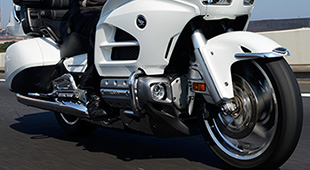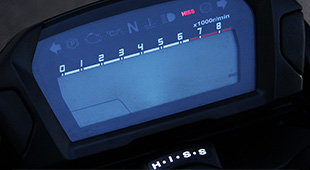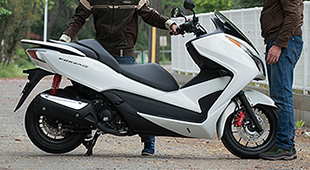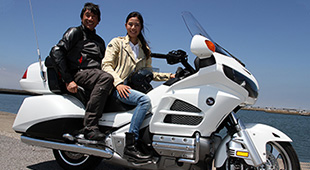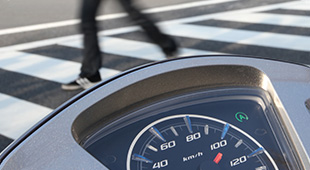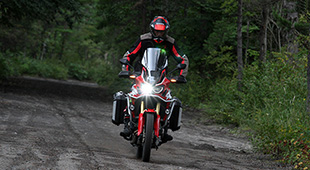Tech Views — Vol.1 Dual Clutch Transmission
NC700X (Dual Clutch Transmission)

NC700X (Dual Clutch Transmission)
It's Better Than I Am!
When the NC700 series was released in 2012, Honda eschewed the usual litany of spec numbers, such as displacement and horsepower, acceleration and top speed, and instead focused on the new series' biggest advantages-the captivating power pulses generated by the engine, a riding package that houses a large carrying space where normally the fuel tank resides, and the ability to experience a high level of riding enjoyment at a relatively low price—an entirely new concept that broke with conventional common sense.
What happens when you ride this model, which was released with an emphasis on the joy of riding rather than the usual dry claims about power, technology, or low fuel consumption? The engine produces pulses like a V-twin, delivering strong power and torque in the low-to-midrange revs above idle for a smooth and singularly pleasant ride. Fuel consumption for a 900 kilometer round trip from Tokyo to Suzuka Circuit also recorded remarkably good figures normally not possible with a 700cc motorcycle. This was the debut of a new Honda model that has a completely different appeal from its more established CB, CBR or VFR lineups. And as I rode this model, equipped with its revolutionary transmission, it occurred to me that the combination of the NC700X and Honda's new-generation Dual Clutch Transmission was turning out to be far more than I ever expected.
I first started with the Dual Clutch Transmission set to its fully automatic D (Drive) mode. Slightly opening the throttle resulted in astoundingly smooth and precise clutch work at around 1,500 rpms. Of course, it wasn't me, but the Dual Clutch Transmission that was responsible for this (a Dual Clutch Transmission motorcycle has neither clutch lever nor shift pedal!), and the bike made a perfect start every time. The NC's engine produces ample low-end torque, and shifts up at about 2,000 rpms, steadily picking up speed. Like a manual shift motorcycle, the NC700X's acceleration has a feeling of direct operation, and the smooth ride continues with its Dual Clutch Transmission, providing a pleasant engine pulsation.
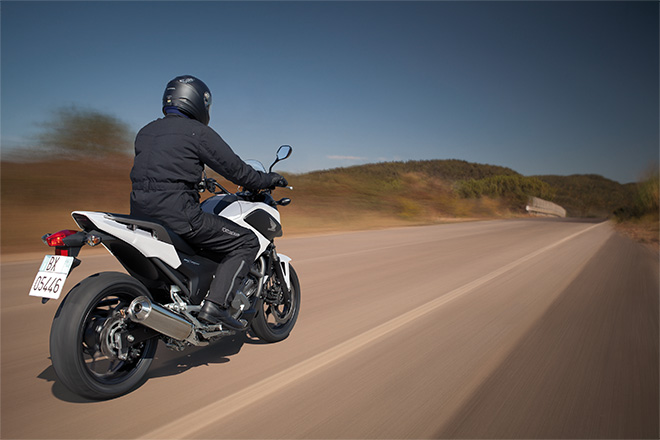
At first I thought that I could ride more briskly through town with the manual transmission version rather than the Dual Clutch model, but it turned out that there was virtually no difference between the two. Instead, I found that by leaving all shifting operation to the Dual Clutch Transmission by setting it in D mode, I could just relax and concentrate on riding through town, with all its assorted obstacles. I also tried some small-radius U-turns, thinking that a rider could better control the clutch in this maneuver. However, no matter how hard I tried, the feeling of the Dual Clutch Transmission's overall control stability was Pro class all the way.
This day I set out for the mountains and the many wonderful winding roads in that area. I also wanted to test the NC700X's capability as an adventure bike, so I planned to ride off into the dirt as well.
With the Dual Clutch Transmission, the gears can also be shifted manually using the left index finger to shift up and the thumb to shift down. This can even be done to use engine braking to set up for a corner. Here downshifting is just as important as hard braking, and in such cases the Dual Clutch Transmission downshifts beautifully. Because of its two clutches, as its name suggests, power is delivered to the rear wheel without a break, so downshifts are quick and smooth, with virtually no slipping of the tire, even without loudly revving the throttle.
By the time I was finished, I was pretty taken by the Dual Clutch Transmission's charms. I could ride with total concentration on braking and lines, and looking out for any small stones in the road ahead.
As I turned onto a dirt road lined with a beautiful stand of trees, I opened the throttle and the rear wheel slipped slightly as I accelerated, rapidly increasing speed as the wheel spun a bit. Then, uh-oh, a big gap in the road-time to get up on the pegs. The downshift button is really easy to use from this position. Good. Since my left foot was free of the gear shifter, I no longer had to worry about accidentally shifting gears when suddenly hitting a bump in this position. The Dual Clutch Transmission suddenly became a sort of secret weapon for the dirt.
Since that day, I've come to look forward to riding a bike with the Dual Clutch Transmission. It always seems to perform its clutch work and gear shifting perfectly, which is a great advantage, even when wanting to get into some brisk riding. Motorcycles are freedom machines, and the Dual Clutch Transmission lets you enjoy that freedom all the more. I must confess that I was really surprised to finally come to understand how much riding styles can differ without clutch operation. This newfound understanding was especially significant for me.
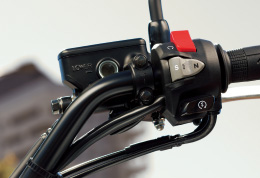
The S–D-N thumb switch on the right lets you switch instantly into Drive or Sport automatic models from Neutral.
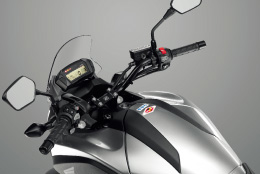

On Dual Clutch Transmission models, the left-side switch module has a large thumb switch (-) for downshifts and a protruding index finger switch (+) at the front for shifting up. Next to the switch module is a large parking brake lever.

The right-side engine cover of the NC700X's Dual Clutch Transmission version is shaped differently from its manual transmission counterpart.
TRANSMISSION TECHNOLOGIES - DUAL CLUTCH TRANSMISSION -
Honda has developed a motorcycle transmission with automated clutch and shift operation that delivers the same riding enjoyment as a manual transmission.

